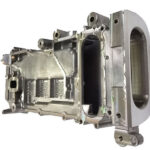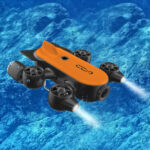1. Lever micrometers of precision machinery processing plants
1. The lever micrometer of the precision machinery processing plant is also called the indicating micrometer. It is a precision measuring tool composed of the micrometer part of the outer diameter micrometer and the indicating mechanism in the lever caliper.
2. The indicating value of the lever micrometer is 0.002mm, and the indicating range is ±0.06mm.
r1=2.54mm, r2=12.195mm, r3=3.195mm, pointer length R=18.5mm, z1=312, z2=12, then the transmission magnification ratio k is:
That is, when the movable anvil moves 0.002mm, the pointer turns one division.
The reading value b is: b≈0.002 k = 0.002×723mm = 1.446mm
The lever micrometer can be used for relative measurement or as an absolute measurement like a micrometer. There are two kinds of graduations: 0.001mm and 0.002mm.
The precision mechanical processing plant lever micrometer not only has higher reading accuracy, but also because of the greater rigidity of the arch frame, the measuring force is generated by a small spring, which is more stable than the measuring force produced by the ratchet device of the ordinary micrometer. Therefore, its actual measurement accuracy is also higher. high.
3. Precautions for use
Before making relative measurement with lever caliper or lever micrometer, the zero position should be adjusted according to the size of the workpiece to be measured and the measuring block.
During measurement, press the retreat button to allow the surface of the measuring rod to lightly touch the workpiece, and do not harden it to prevent the measurement surface from being worn out and affecting the accuracy.
When measuring the diameter of the workpiece, the measuring tool should be swung, and the turning point reading of the pointer is the correct measurement value.
2. Inner diameter centimeter of precision machinery processing plant
The inner diameter centimeter of the precision machinery processing plant has the same reading method as the outer diameter centimeter.
The inner diameter centimeter is mainly used to measure large apertures. In order to adapt to the measurement of different aperture sizes, extension rods can be connected. When connecting, only need to unscrew the protective cap 5, and screw the right end (with internal thread) of the extension rod to the left end of the centimeter. The extension rods can be connected one by one, and the measurement range can reach up to 5000mm.
The inner diameter centimeter and extension rod are supplied as a set. At present, the measuring range of domestic internal diameter centimeters (mm): 50~250; 50~600; 100~1225; 100~1500; 100~5000; 150~1250; 150~1400; 150~2000; 150~3000; 150-4000; 150-5000; 250-2000; 250-4000; 250-5000; 1000-3000; 1000-4000; 1000-5000; 2500-5000. Reading value (mm): 0.01.
There is no force measuring device on the inner diameter centimeter, and the pressure measurement depends entirely on the feeling in the hand.
When measuring, after adjusting it to the measured size, gently put it into the hole to test whether the tightness of its contact is appropriate. One end does not move, the other end swings left, right, front and back. When swinging from side to side, you must carefully place it in the diameter direction of the hole to be measured, and make point contact, that is, at the largest size of the measurement hole (the largest reading), to prevent wrong positions.
The back and forth swing should be at the smallest size of the measuring aperture (ie, the smallest reading). According to these two requirements, lightly touch the hole wall to read the correct value of the diameter. When measuring, it is wrong to force the inner diameter centimeter to press over the aperture. This not only causes premature wear of the measuring surface, but also damages the accuracy of the measuring tool and makes the measurement result inaccurate after the slender measuring rod is bent and deformed.
The indication error of the inner diameter centimeter is relatively large, such as measuring the inner diameter of 0~600mm, the indication error is ±0.01~0.02mm.
Therefore, when measuring the inner diameter with high accuracy, the inner diameter centimeter should be adjusted to the measurement size, and then placed on the same size composed of gauge blocks for calibration, or the tightness of the inner size measurement and the measurement block group The tightness of the size is compared to overcome the shortcomings of large error of indication.
In addition to measuring the inner diameter, the inner diameter centimeter can also be used to measure inner dimensions such as the groove width and the distance between the two inner end faces of the body. However, the size below 50mm cannot be measured, and an internal measuring centimeter is required.
3. Internal test centimeters in precision machinery processing plants
The internal measuring centimeter of the precision machinery processing plant measures the inner diameter of small dimensions and the width of the inner side groove. Its characteristic is that it is easy to align the diameter of the inner hole and the measurement is convenient. The reading value of the domestically-made internal measuring centimeter is 0.01mm, and the measuring range is 5~30 and 25~50mm, and the internal measuring centimeter of 5~30mm. The reading method of the inner measuring centimeter is the same as that of the outer diameter centimeter, except that the size of the engraved line on the sleeve is opposite to the outer diameter centimeter, and its measuring direction and reading direction are also opposite to the outer diameter centimeter.
4. Three-jaw inner diameter micrometer in precision machinery processing plant
Three-jaw inner diameter micrometer, suitable for measuring small and medium diameter precision inner holes, especially suitable for measuring the diameter of deep holes. Measuring range (mm): 6~8,8~10,10~12,11~14,14~17,17~20,20~25,25~30,30~35,35~40,40~50, 50-60, 60-70, 70-80, 80-90, 90-100. The zero position of the three-jaw inner diameter micrometer must be calibrated in the standard hole.
The working principle of the three-jaw inner diameter micrometer, the measuring range of the three-jaw inner diameter micrometer is 11-14mm. When the force measuring device 6 is rotated clockwise, it will drive the micrometer screw 3 to rotate and make it follow the spiral direction of the threaded shaft sleeve 4. Move, so the square conical thread at the end of the micrometer screw pushes the three measuring claws 1 to move radially. The elastic force of the torsion spring 2 makes the measuring claw fit tightly on the square conical thread, and expand and contract with the advance and retreat of the micrometer screw.
The radial pitch of the square taper thread of the three-jaw inner micrometer is 0.25mm. That is, when the force measuring device rotates one cycle clockwise, the measuring claw 1 moves outward (in the radial direction) by 0.25 mm, and the diameter of the circle composed of the three measuring claws will increase by 0.5 mm. That is, when the microtube rotates once, the measuring diameter increases by 0.5mm and 100 equal divisions are engraved on the circumference of the microtube, so its reading value is 0.5mm÷100=0.005mm.
5. Micrometer of common normal line length of precision machinery processing plant
The length of the common normal is a micrometer. It is mainly used to measure the length of the common normal line of two different tooth surfaces of external meshing cylindrical gears. It can also be used to check the original outline dimensions of the gear to be cut according to the common normal line of the cut gear when checking the accuracy of the gear cutting machine. Its structure is the same as the outer diameter centimeter, the difference is that two measuring clamps (measuring surfaces) with precise planes are installed on the measuring surface to replace the original measuring anvil surface.
Measuring range (mm): 0-25, 25-50, 50-75, 75-100, 100-125, 125-150. Reading value (mm) 0.01. Measuring modulus m (mm) ≥ 1.
Six, wall thickness micrometer
Wall thickness micrometer. Mainly used to measure the wall thickness of precision tubular parts. The measuring surface of the wall thickness micrometer is inlaid with cemented carbide to increase the service life.
Measuring range (mm): 0~10, 0~15, 0~25, 25~50, 50~75, 75~100. Reading value (mm) 0.01.
Seven, plate thickness centimeter
The thickness of the board is 100 centimeters. It is mainly suitable for measuring the thickness of sheet metal. Its specifications are shown in Table 1.
8. Pointed Micrometer
Pointed micrometers are mainly used to measure the thickness, length, diameter and small grooves of parts. Such as the groove diameter of drill bits and even-numbered groove taps.
Measuring range (mm): 0~25, 25~50, 50~75, 75~100. Reading value (mm) 0.01.
Nine, thread micrometer
Thread micrometer. Mainly used to measure the pitch diameter of ordinary threads.
The structure of the thread micrometer is similar to the outer diameter centimeter, the difference is that it has two special interchangeable measuring heads 1 and 2, the angle of which is the same as the thread profile angle.
The measuring range and measuring pitch range are shown in Table 2.
10. Depth centimeter
Depth centimeters are used to measure hole depth, groove depth and step height. Its structure, except that the base is used instead of the ruler frame and the measuring anvil, is no different from the outer diameter centimeter.
The reading range of the depth gauge (mm): 0-25, 25-100, 100-150, and the reading value (mm) is 0.01.
Its measuring rod 6 is made into a replaceable form, and after replacement, it is locked with a locking device 4. Huiwen Zhizao is a machining factory with more than ten years of Cnc Machining experience. It has complete equipment, CNC turning/milling/grinding/drilling/processing. Partners with parts processing needs are welcome to contact us for quotation.
The zero calibration of the depth centimeter can be carried out on a precision plane. That is, when the end face of the base and the end face of the measuring rod are in the same plane, the zero line of the microtube is exactly aligned. When the measuring rod is replaced, the zero position will generally not change.
When measuring the depth of the hole with a depth centimeter, the measuring surface of the base 5 should be closely attached to the end surface of the hole to be measured. This end surface of the part should be perpendicular to the center line of the hole, and should be smooth and flat, so that the measuring rod of the depth centimeter is parallel to the center line of the hole to be tested to ensure the measurement accuracy. At this time, measure the distance from the end face of the rod to the end face of the base, which is the depth of the hole
11. Digital outer diameter centimeter
Recently, my country has a digital outer diameter centimeter, which is more convenient to use because it uses a number to indicate the reading. There is also a vernier engraved on the fixed sleeve, and the reading value of 0.002 or 0.001mm can be read by the vernier.
Link to this article:Introduction to measuring tools commonly used in precision machinery processing plants
Reprint Statement: If there are no special instructions, all articles on this site are original. Please indicate the source for reprinting.:Cnc Machining,Thank!^^




